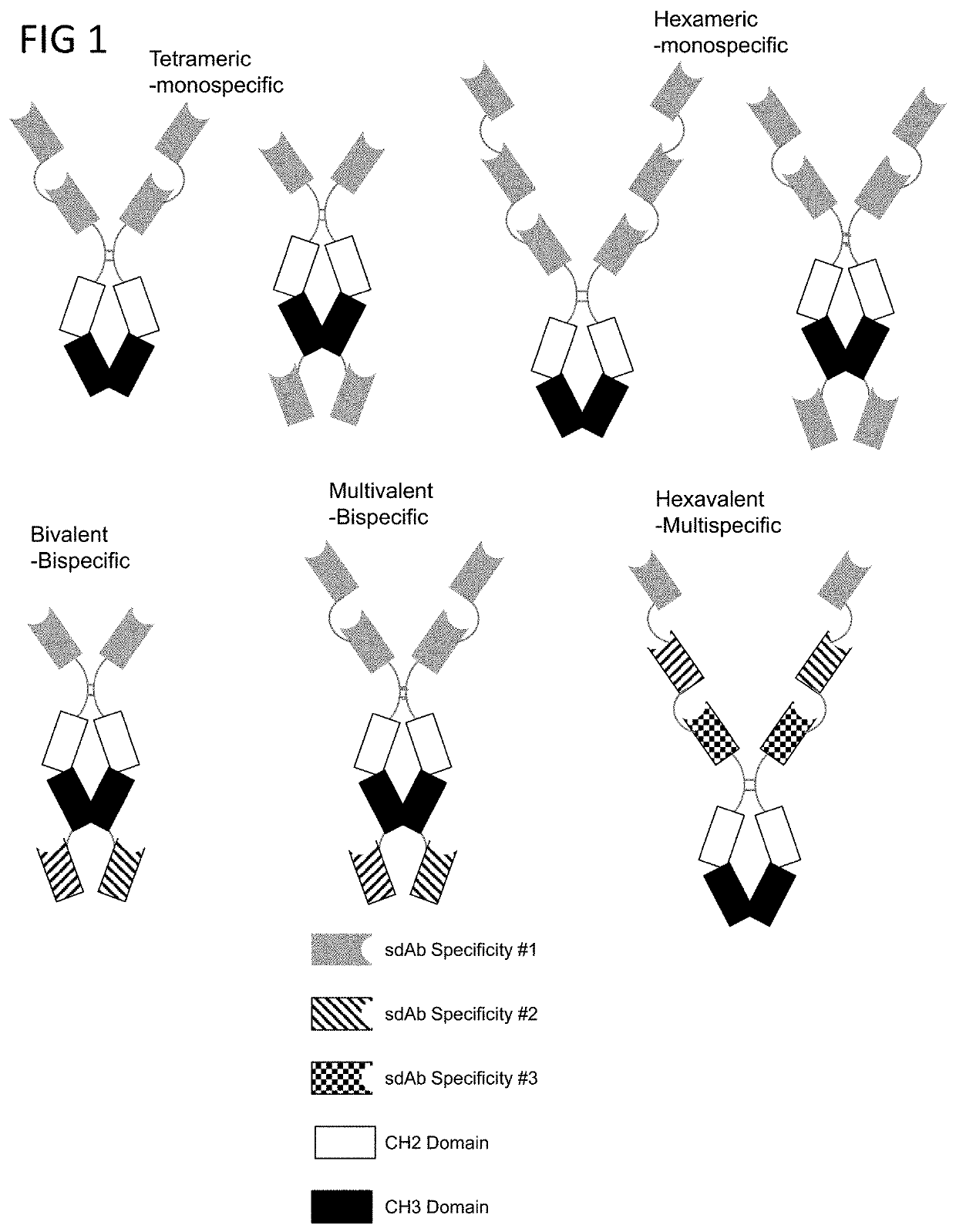Multivalent and Multispecific OX40-Binding Fusion Proteins
a fusion protein, multi-specific technology, applied in the direction of antibody medical ingredients, drug compositions, immunological disorders, etc., can solve the problems of unsatisfactory conventional bivalent antibodies, achieve enhanced tumor destruction, dampen inflammatory insult, and enhance treg proliferation
- Summary
- Abstract
- Description
- Claims
- Application Information
AI Technical Summary
Benefits of technology
Problems solved by technology
Method used
Image
Examples
example 1
eting Single Domain Antibodies Bind OX40
[0186]The OX40-targeting single domain antibodies (sdAbs) referred to herein as 1A06 (SEQ ID NO: 16), 2B07, 2C09 (SEQ ID NO: 19), 1D10 (SEQ ID NO: 22), 2E4 (SEQ ID NO: 18), 2H06 (SEQ ID NO: 17), 3E11 (SEQ ID NO: 23), 3G9 (SEQ ID NO: 24), and G3 (SEQ ID NO: 25) bind cell surface OX40 expressed on CHO cells (FIGS. 2A-2B). Binding was assessed by flow cytometry using OX40 expressing CHO cells and data is presented as median fluorescence intensity.
[0187]The OX40-targeting sdAbs referred to herein as 1D10, G3, and 3E11 were also evaluated for their ability to bind cynomolgus OX40 expressed on CHO cells (FIG. 4). Binding was assessed by flow cytometry using cynoOX40 expressing CHO cells and data is presented as median fluorescence intensity.
[0188]Various humanized versions of OX40-targeting sdAbs coupled to an Fc region were also evaluated for their ability to bind human OX40 and cynomolgus OX40 (FIGS. 12A and 12B). Binding was assessed by flow cyto...
example 2
eting Single Domain Antibodies Block OX40
[0189]The OX40-targeting single domain antibodies (sdAbs) referred to herein as 1D10 (SEQ ID NO: 22), 2E4 (SEQ ID NO: 18), G3 (SEQ ID NO: 25), 3E11 (SEQ ID NO: 23), and H11 block the interaction between OX40 and OX40L. As shown in FIG. 3, 2E4 blocks the interaction between OX40 and OX40L, while the other single domain antibodies do not. A single domain antibody that binds GITR was included as a negative control. Blocking was assessed by flow cytometry using a OX40L-citrine fusion protein and data is presented as median fluorescence intensity.
example 3
nt OX40-Targeting Molecules
[0190]Multiple copies of binding domains, such as, for example, single domain antibodies (sdAbs), can be operably linked together to produce multivalent OX-40 targeting molecules. In some embodiments, multiple OX40-targeting VHHs are operably linked to an Fc region polypeptide to produce multivalent OX40-targeting molecules.
[0191]FIG. 5A is schematic depicting the format of various embodiments of multivalent OX40 binding fusion proteins and the estimated molecular weights for each. FIG. 5B is a photograph of a Coomassie blue stain SDS-PAGE gel of multivalent OX40 binding fusion proteins under reducing and non-reducing conditions.
[0192]The OX40 multivalent molecules exhibit that enhanced OX40 signaling is mediated by higher valency binding. FIG. 6 depicts the comparison between tetravalent and bivalent binding of OX40 using the fusion proteins of the present disclosure. OX40 signaling was monitored using an NF-kB reporter 293 cell line expressing OX40. Fusi...
PUM
| Property | Measurement | Unit |
|---|---|---|
| dissociation constant | aaaaa | aaaaa |
| dissociation constant | aaaaa | aaaaa |
| width | aaaaa | aaaaa |
Abstract
Description
Claims
Application Information
 Login to View More
Login to View More - R&D
- Intellectual Property
- Life Sciences
- Materials
- Tech Scout
- Unparalleled Data Quality
- Higher Quality Content
- 60% Fewer Hallucinations
Browse by: Latest US Patents, China's latest patents, Technical Efficacy Thesaurus, Application Domain, Technology Topic, Popular Technical Reports.
© 2025 PatSnap. All rights reserved.Legal|Privacy policy|Modern Slavery Act Transparency Statement|Sitemap|About US| Contact US: help@patsnap.com



